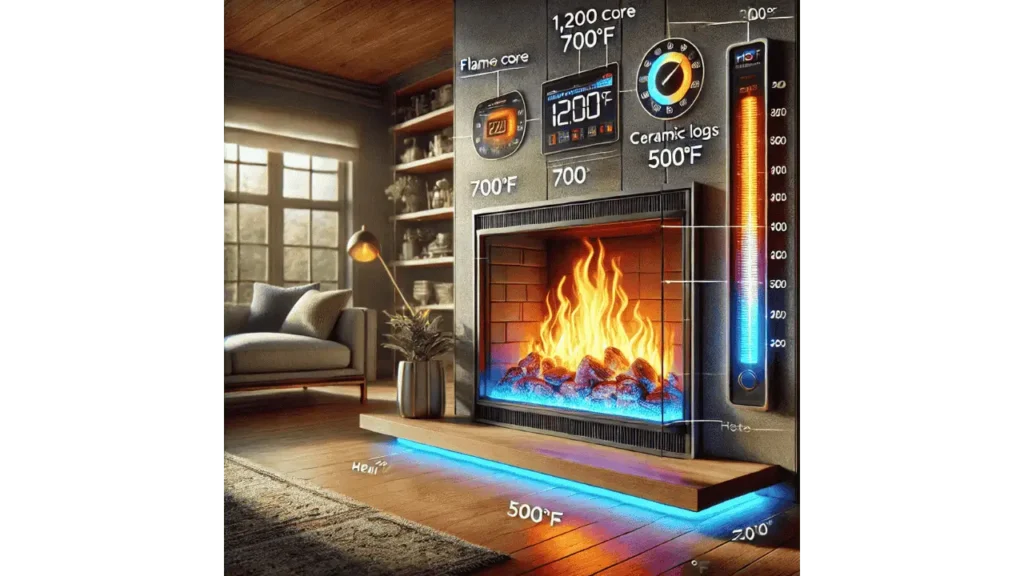Fireplaces are a popular way to add warmth and ambiance to a home, but they can reach high temperatures that require careful management. Understanding how hot a fireplace can get and the factors that influence its temperature helps homeowners use their fireplaces safely and efficiently.

Types Of Heat:
Fireplaces generate heat in different ways depending on their type and fuel source. The three primary types of heat generated are convection, conduction, and radiation.
Convection Heat:
This type of heat occurs when warm air rises and circulates throughout the room. Fireplaces that utilize convection heat, such as gas and electric models, pull in cool air, heat it, and then release it back into space. This helps evenly distribute warmth, making it an efficient method for heating large areas.
Read More: Are Propane Fireplaces Safe?
Conduction Heat:
Conduction refers to the transfer of heat through solid materials, such as the fireplace structure and surrounding walls. This type of heat warms up surfaces and objects in direct contact with the fireplace, such as mantels and hearths. Materials like brick and stone are excellent conductors, helping retain and slowly release heat over time.
Radiation Heat:
Radiation heat travels directly from the fire to nearby objects and people without warming the air in between. This type of heat is most noticeable when sitting close to the fireplace, as it provides immediate warmth. Wood-burning fireplaces, in particular, generate significant radiant heat, creating a cozy and inviting atmosphere.
Wood-burning fireplaces typically produce a combination of all three heat types, with radiation being the most noticeable. Gas fireplaces primarily use convection and radiation, making them efficient for heating specific areas.
Radiation Temperature:
Radiation temperature refers to the heat emitted directly from the flames and surrounding materials of the fireplace. Depending on the type of fireplace, temperatures can range significantly. Wood-burning fireplaces can produce temperatures as high as 1,100 degrees Fahrenheit, with the surrounding materials absorbing and radiating heat. Gas fireplaces, on the other hand, generally reach temperatures between 500 to 1,000 degrees Fahrenheit.
The temperature of the radiant heat is influenced by factors such as fuel type, air supply, and the design of the fireplace. Proper ventilation and regular maintenance help ensure that the fireplace operates at safe temperatures.
How Hot Is The Average Temperature Of A Fireplace?
On average, fireplaces reach temperatures between 700 and 1,200 degrees Fahrenheit, depending on the fuel source and the efficiency of the fireplace. Wood-burning fireplaces often burn hotter due to the combustion process, while gas fireplaces provide a more controlled and consistent level of heat.
Electric fireplaces, in contrast, generate significantly lower temperatures, typically ranging between 150 and 300 degrees Fahrenheit. While they don’t produce real flames, they provide a safer alternative for heating small spaces.
How To Protect Your Home From Your Fireplace?
Given the high temperatures a fireplace can reach, it’s essential to take steps to protect your home and ensure safety. Installing heat-resistant materials such as fireproof tiles or stone around the fireplace can prevent heat damage to surrounding structures. A proper fireplace screen or glass door can help contain sparks and reduce direct heat exposure.
Regular maintenance, including chimney inspections and cleaning, helps prevent excessive heat buildup and potential fire hazards. Keeping flammable objects such as furniture and curtains at a safe distance from the fireplace minimizes the risk of accidental fires.
Using a fireplace responsibly by following manufacturer guidelines and ensuring adequate ventilation is key to maintaining a safe and comfortable home environment.
Conclusion:
Fireplaces can reach extreme temperatures depending on their type and fuel source. Understanding how heat is generated and taking the necessary precautions to protect your home ensures safe and efficient use. Regular maintenance and proper installation of protective measures can help homeowners enjoy the warmth of their fireplace without compromising safety.
- How to Build an Electric Fireplace Wall? - June 4, 2025
- How to Clean an Electric Fireplace? - June 3, 2025
- How to Fix an Electric Fireplace? - June 2, 2025

